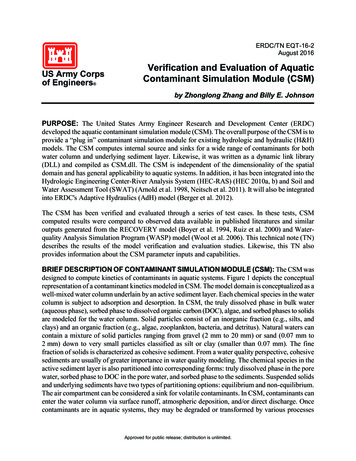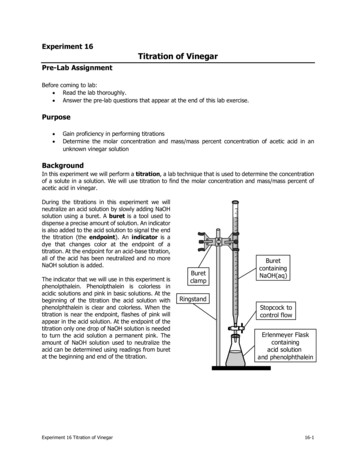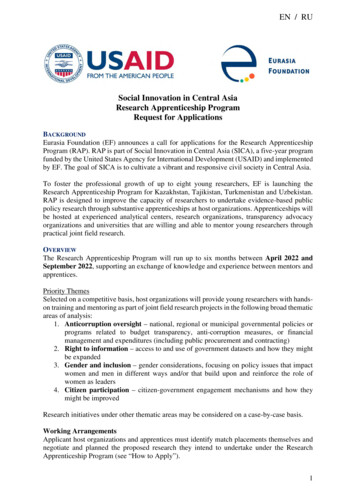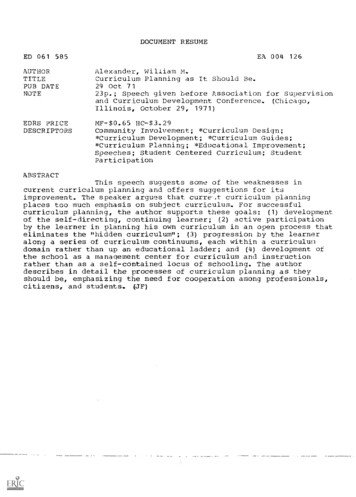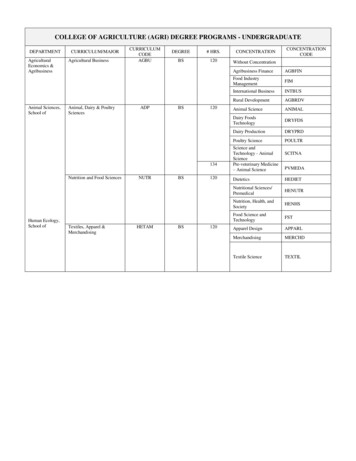
Transcription
Information Systems Education Journal (ISEDJ)ISSN: 1545-679X13 (1)January 2015A Proposed Concentration Curriculum Design forBig Data Analytics for Information SystemsStudentsJohn C. Molluzzojmolluzzo@pace.eduJames P. Lawlerjlawler@pace.eduPace UniversityOne Pace PlazaNew York, New York 10038AbstractBig Data is becoming a critical component of the Information Systems curriculum. Educators areenhancing gradually the concentration curriculum for Big Data in schools of computer science andinformation systems. This paper proposes a creative curriculum design for Big Data Analytics for aprogram at a major metropolitan university. The design emphasizes expanded learning of business,mathematical and statistical, and presentation skills, in projects of teams, in addition to skills intechnology. This paper will be beneficial to educators considering improvement of the curriculum forBig Data Analytics and to students desiring a more contemporary program.Keywords: analytics, big data, computing curricula, data mining, data science, privacy, security.1. BACKGROUND AND DEFINITION“Data is the New Oil” (Smolan and Erwitt, 2012).Big Data is defined as “bigger and bigger andbigger” (Aiden, & Michel, 2013) aggregates ofdata that challenge business firms in analyzingbusiness benefit with common software. BigData dimensions are defined in a diverse on data, and non-structured data, suchas mobile sensor and social media networkingdata; in a velocity as to rapid sensitivity to realtime timeliness of the data; in a veracity as tothe purity of sizable volume; and in sheerstreaming volume (Ohlhorst, 2013). Big Data isessentially a data management paradigm shift(Borkovich, & Noah, 2013).Big Data isestimated to be in dozens of terabytes tomultiples of petabytes (IBM, 2014), growing50% each year and 100% every 2 years inbusiness firms (Lohr, 2012); and is estimated tobe further impacted by increased informationfrom the “internet of things” (Morozov, 2014),such as consumer wearables (Minsker, 2014a).Firms in the retail industry, such as Walmart,store 2.5 petabytes or 1 quadrillion bytes of data(McAfee, & Brynjolfsson, 2012). The storing ofdata however is less important than the businessbenefit to be acquired from the analysis of thedata, in cost control, decision improvement anddesign improvements in processes, products andservices (Davenport, 2014), especially from thecross-fertilization of customer social networkingand transaction data streaming into firms(Brustein, 2014). The accessibility of such datais apparently a “big deal” (eWeek, 2013), asfirms exploit the potential of data analytics in 2015 EDSIG (Education Special Interest Group of the AITP)www.aitp-edsig.org /www.isedj.orgPage 45
Information Systems Education Journal (ISEDJ)ISSN: 1545-679Xthisperceived(Freeland, 2012).revolutionoftechnologyThe benefits of Big Data Analytics (henceforthreferred to as BDA) are cited frequently in firms(IBM, 2014).Amazon is analyzing data forcompetitive customer micro-segmentation ofproducts to customize its products and services;Google is analyzing messaging to improve itsservices (Rosenblatt, 2014); and Tesco andWalmart are analyzing demographics to lowerinventory pricing of products and services attheir stores. Twitter is analyzing hashtags formore patterns of potential sales from subjecttrends. Firms are clearly interested in BDA tooptimize the outcomes of processes, productsand services. Even the government and thehealth industry (Kim, Trimi, & Chung, 2014) arecommencing initiatives in efficiency, decisionimprovement and cost control from BDA tooptimize the outcomes of processes and services(Liyakasa, 2013). Though firms may be storingincreased data without increased insight(Minsker, 2014b), the potential of BDA as aprofitable attribute, beyond the benefits ofBusiness Intelligence and Operations Research,is evident in the literature (King, 2014). Thispotential invites consideration of BDA as adifferential feature of learning in schools ofcomputer science and information systems.Graduates from schools of computer science andinformation systems can contribute to the fieldof data analytics if the curricula of the schoolsinclude BDA. Though firms are investing in BDA,they do not have enough data scientists orspecialists (May, 2013) for extracting thepotential of their data (McCafferty, 2013).Graduates can contribute to the field if theyhaveanalyticalbusinessskills(Janicki,Cummings, & Kline, 2013) and content domainexpertise skills (Poremba, 2013) to criticallyevaluate the business (Pratt, 2013) of Big Data.They can contribute to this evaluation if theyhave computational mathematical and statisticalskills (Hulme, 2013), can interpret in a highperformance environment the complex eventsignificances of structured and non-structureddata, and evaluate potential problem solutionsor proposed strategies (Pratt, 2013). They cancontribute further if they have privacy andsecurity sensitivity skills in standards for BigData housed by organizations, especially givenintrusion issues as discussed in the literature(Lohr, 2013, Sengupta, 2013, & Angwin, 2014).Moreover, they can contribute notably to thefield if they have persuasive presentation skills13 (1)January 2015(Miller, 2013), as individual contributors ormembers of teams, in proposing solutions andstrategies; and they can contribute powerfully ifthey have skills in visualization (Rao, & Halter,2013). These skills are beyond the data baseanalysis, design and development skills intechnology (King, 2013).Though fewgraduates, or even practitioners in industry(MacSweeney, 2013a), have all of these skills tobe data scientists, a creative curriculum designin Data Science may improve the breadth ofensemble learning for students currentlyenrolled in schools of computer science andinformation systems.2. FOCUS OF PAPER“The Big Data [R]evolution holds the promise ofempowering all of us with knowledge” (Smolanand Erwitt, 2012).The proposed concentration of Data Science atPace University is the focus of this paper. Thefocus is apt, as firms desire BDA personnel butdo not have enough expertise for initiatives onprojects (Davenport, 2014). Many firms have aBDA expertise gap (Olavsrud, 2014), despite thehype of pundits. The literature indicates thatindustry needs 140.0 – 190.0 thousand BDAprofessionals if not data scientists in 2014(Manyika,Chui,Brown,Bughin,Dobbs,Roxburgh, & Byers, 2011) and even a high of4.4 million scientists in 2015 (IBM, 2014). Eventhough a concentration of Data Science is notenough for an immediate solution, theconvergence is current to the expectations ofindustry and organizations, as they initiateinvestment in Big Data strategies (Messmer,2014). The focus of this paper on the DataScience curriculum will benefit educators andstudentsdesiringafoundationforanimmediately marketable program.3. CONCENTRATION METHODOLOGY – DATASCIENCE“Having the data is only the beginning “(Smolanand Erwitt, 2012).Pace University is anticipating beginning aconcentration in Data Science in 2015 with theoffering of the Concepts of Big Data Analyticscourse. The concentration covers descriptive,predictive and prescriptive analytics (Camm,Cochran, Fry, Ohlmann, Anderson, Sweeney, &Williams, 2015) for data-driven decision making.The concentration is designed for undergraduate 2015 EDSIG (Education Special Interest Group of the AITP)www.aitp-edsig.org /www.isedj.orgPage 46
Information Systems Education Journal (ISEDJ)ISSN: 1545-679Xstudents to learn business, mathematical andstatistical, presentation, team-playing and highlevel technology skills. In the concentration,projects are assigned to incubating pseudo datascientist teams (O’Neil, & Schutt, n, 2013) of 3–5 individuals.Theprojects are focused on the design of processes,products or services in a discrete industry, suchas energy, entertainment, finance, health andlife sciences, or retail. The projects are to befocused on BDA problems in the industries andare to be furnished with data sets of a massivescale from non-proprietary Web sites andsystems, such as www.data.gov, www.enigma.io(Singer, 2014) and www.openwebanalytics.com.The projects are to include internship andmentoring of the student teams from a few firmsin the industry that are partnered with theschoolandevenhavedataanalyticsemployment positions (ITBusinessEdge, 2014).In 2016–2017 a few boutique data scientistfirms may be partnered with the school.Technologies in the concentration include, butare not limited to, Apache, Hadoop, MapReduce,NLP for text, NoSQL, Python tools (Knorr, 2013)and SAS tools.The concentration in DataScience is planned to begin in 2016–2017 afterthe Concepts of Big Data Analytics course, byexpanded learning of mathematical, statisticaland technology skills that will involve otherfaculty (King, 2013) in the school. Few schoolsof computer science and information systemshave curriculum design initiatives in DataScience (MacSweeney, 2013b) as envisioned inthis paper.The generic learning objectives of the DataScience concentration are defined below: Analyze a business process, product or serviceforexperimentalimprovementinanorganization that can benefit by BDA; Collaboratively design a discovery andexploratory method for interpreting thecustomer data domain dynamics of theprocess, product or service that includestructured and unstructured data sources; Collaboratively develop a conceptual databusiness model for the process, product orservice problem and for the solution, infusedby intelligence learned in the discovery andexploratory process and by leveraging of aBDA tool(s), integrating a data service processprototype scenario(s) – what can the firm do13 (1)January 2015better now with the information that it couldnot do before it had it? (Provost, & Fawcett,2013); Collaboratively develop a governance plan forthe new product or service or a processsolution for the firm, informed by customerdata privacy rights and security sensitivitystandards; and Formulate an organizational production planfor integrating the data sources, systems andtechnologies for the proposed process, productor service solution and for integrating BDA asan overall business strategy.The proposed courses in the concentration are 3credits. The outcomes of the concentration arein analytical business skills, creative problemsolving skills, Big Data modeling skills,fundamental mathematical and statistical skills,and presentation and team-playing skills, andalso privacy and security sensitivity skills. Thegoal of the concentration is for its graduates tobe business data scientists, not mere scientisttechnologists. The curriculum is a foundationfrom which there may be employment postingsof BDA specialties for the students upongraduation from the university.Pending approval by an internal curriculumcommittee of the school, the concentration ofData Science will begin in fall 2015 with theoffering of Concepts of Big Data Analytics, asdiscussed in this paper. The plan is to rollout thefull concentration during 2015–2017 with thefollowing courses.Concept Courses Concepts of Big Data Analytics, a course oncritical Big Data modeling of a process,product or service in industry; Big Data Maturity Model, a conceptual courseonbenchmarkingofbestBigDataorganizational practices in industry; and Customer Relationship Management (CRM)and Big Data, a conceptual course integratingBDA and household priority relationshipstrategy in industry.Domain Courses Big Data Analytics in Energy, a domain courseintegrating BDA projects for decision-makingin the energy industry; Big Data Analytics in Entertainment, a domaincourse integrating BDA projects for decision- 2015 EDSIG (Education Special Interest Group of the AITP)www.aitp-edsig.org /www.isedj.orgPage 47
Information Systems Education Journal (ISEDJ)ISSN: 1545-679X13 (1)January 2015making in the entertainment and sportsindustries; Big Data Analytics in the Financial Industry, adomain course integrating BDA projects fordecision-making in the international financialservices industry; Big Data Analytics in Health and Life Sciences,a domain course integrating BDA projects fordecision-making in the health and life sciencesindustry, including ObamaCare initiatives; and Big Data Analytics in Retail Industries, adomain course integrating BDA projects fordecision-making in the retail industries.Enabling Courses Big Data Ethical Framework, an integrativecourse on BDA privacy, regulatory and securitystandards governing analytics professionals inindustries and organizations; and BigDataFoundationTechnology,anintegrative course on required BDA highperformanceinfrastructureplatform andstorage technologies and tools.The concentration of Data Science is depicted inFigure 1. The concentration is fulfilled in thethree conceptual courses, three of the fivedomain courses, and the two enabling courses ofthe plan. The concentration is currently designedfor the undergraduate students of the school butmay be expanded in 2017 for graduate studentsof the School and of the School of Business ofthe university.Table 1 lists courses that can give the studentrequisite skills in business, mathematics,statistics, and presentation, team-playing andhigh-level technology. The descriptions are fairlygeneric and reflect existing courses in mostinstitutions that have a business major.4. COURSE MODEL – BIG DATA ANALYTICS“ Big Data is much more than big data”(Smolan and Erwitt, 2012).The field of data science or data analytics isrelatively new, with few consistencies in thecontent or names of introductory courses.During January-February, 2014, a scan of theInternet disclosed the following names forintroductory courses: Advanced Big Data AnalyticsAnalytics and Decision AnalysisApplied Data Science For this paper, the Concepts of Big DataAnalytics course is outlined in Table 2 of theAppendix.Table 2 contains five columns corresponding tothe online syllabi of five university introductoryData Science or Analytics courses. Over theperiod of February – March 2014, the authorsreviewed the online syllabi of 21 introductorycourses that contained Data Analytics or DataScience in their titles, all from Tier I and Tier IIuniversities. The courses represented in Table 2are a representative sample of the 21 courses.The five columns can be used to compare theConcepts of Big Data Analytics course of thispaper to those at these other universities. Notethat the omission of a checkmark does not meanthe topic is not covered in that course. Thecheckmarks indicate what was available on theWeb sites of the universities. Table 2 does notname the universities corresponding to the fivecolumns, in order to avoid any criticism of theuniversities - table is for comparison only.The Concepts of Big Data Analytics courseemphasizes the concepts behind modern DataScience. The course is conceptual in the sensethat the principles behind Data Science areemphasized rather than the tools with which toimplement them. Therefore, topics such as Rand Python programming, Hadoop, MapReduce,and so on are not covered to any extent in thiscourse. Instead, they are covered, as they areneeded in the domain courses to solve industryspecific problems. Some topics in the courserequire knowledge of probability and statistics.Therefore, the basic statistics course required ofall computing majors is a prerequisite for thiscourse. Because the course has no programmingrequirements, it is accessible to any student intheuniversitywhohasthestatisticsprerequisite, which thus includes all businessmajors in the university. 2015 EDSIG (Education Special Interest Group of the AITP)www.aitp-edsig.org /www.isedj.orgBig Data AnalyticsBusiness AnalyticsBusiness Intelligence and AnalyticsData AnalyticsData Analytics for Information SystemsData and Decision AnalyticsData Warehousing and AnalyticsElements of Data AnalysisIntroduction to Business AnalyticsIntroduction to Data AnalyticsIntroduction to Data ScienceLarge-scale Data AnalysisPage 48
Information Systems Education Journal (ISEDJ)ISSN: 1545-679XThe course emphasizes the strategic value ofdata and the use of Data Science teams in anorganization, and the use of data-drivendecision-making. It introduces students to dataanalytic thinking and Data Science principles tofacilitate communication between businessstakeholders and the Data Science teams. Thecourse also discusses the limitations and pitfalls(e.g., overfitting) of Data Science and thenecessity of human involvement in choosing theright data and evaluating the processes andresults of the Data Science projects. Theultimate goal of this course is to enable studentsto participate in the development and properevaluation of a Data Analytics solution to abusiness problem.The text will be Provost, F., & Fawcett, T.(2013), Data Science for Business: What YouNeed to Know about Data Mining and DataAnalytic Thinking. Supporting texts will beDavenport, T.H. (2014), Big Data at . Alternately the following can beused as the text: Davenport, T.H., & Harris, J.G.(2007), Competing on Analytics: The NewScience of Winning. The text will supplementedby Analysis INFORMS Magazine.The course will also discuss in detail severalrecent case studies of the application of BDA toreal business situations. There are many onlineresources to obtain such cases, (e.g., BDA sitesof IBM [2014] and HP Vertica [2014])5. IMPLICATIONS“Big Data started as a series of small waves butis morphing into the greatest tsunami ofinformation that humans have ever seen”(Smolan and Erwitt, 2012).The terms “Big Data”, “Data Science”, “DataAnalytics” are so ubiquitous in the practitionerpress that it seems that they are just the nexthyped fad that will fade into oblivion in a fewyears. However, with the ability to process andstore the many kinds of data collected by firmsand organizations, and the need to use thesedata to strategic advantage, the field of DataScience will not disappear soon. Several studies,such as Brynjolfsson, Hitt, and Kim (2011), andTambe (2014), have shown that the more datadriven a firm, the more successful is the firm.Therefore, more and more organizations will behiring data scientists to take advantage of theirever-growing store of data. There is, however, a13 (1)January 2015problem – our universities are not keeping upwith the demand.There will be a shortage of talentnecessary for organizations to takeadvantage of big data. By 2018, theUnited States alone could face ashortage of 140,000 to 190,000 peoplewith deep analytical skills as well as1.5 million managers and analysts withthe know-how to use the analysis ofbig data to make effective decisions.(Manyika, et al, 2011).Therefore, it is important for universities tobegin developing data scientists who have therequisite technical skills, and the business andcontent domain knowledge to leverage the datathat organizations are now accumulating foradvantage (Gillespie, 2014). The program inData Science proposed in this paper helps to fillthis need.6. LIMITATIONS AND OPPORTUNITIESThe concentration of Data Science and thecourse on Big Data Analytics are beginning as aprogram in fall 2015, but evaluation of theimpact of the initial program on the studentsmay not be finished until fall 2016.The curriculum for Data Science with Big DataAnalytics is not clearly defined in the literature(Dietrich, Newton, & Corley, 2013), and the fieldis immature in instruction. Within the next year,the authors plan to survey instructors ofintroductory Data Analytics and Data Sciencecourses with a view towards determining whichtopics are essential for such courses, and whichtopics are less so. The authors hope that thisfuture research will help create a common coreof topics for an introductory course in DataAnalytics/Data Science.The curriculum design in this paper furnishesimportant input to instructors in schools ofcomputer science and information systems whowant to have an initial program in tandem withtrends.The literature indicates BDA as adesirable norm in organizations (Ohlhorst,2013), an opportunity for the response ofschools of computer science and informationsystems. The model of this paper provides afirst step. 2015 EDSIG (Education Special Interest Group of the AITP)www.aitp-edsig.org /www.isedj.orgPage 49
Information Systems Education Journal (ISEDJ)ISSN: 1545-679X13 (1)January 20157. CONCLUSIONThis paper posits a curriculum design of Big DataAnalytics in the proposed concentration of DataScience at Pace University. The design includesa discovery and exploratory method of criticalBig Data modeling and the improvement of aprocess, product or service in industry. Thedesign provides for inclusion of an organizationalplan for process, product or service solutions,and a production strategy integrating nontraditional and traditional technologies and BDAtools. The design further provides privacy rightsand security sensitivity standards. The design isideal as firms and organizations pursue BDAprojects.Few organizations have the fullprerequisite skills for BDA projects andstrategies. Throughout this paper, the design ofBDA proposes the relevance of business,mathematical and statistical, and presentationand team-playing skills, augmenting prerequisiteskills in the traditional data base managementtechnologies and in the new non-traditional BDAtools. Overall, this paper provides a beneficialproposal to instructors desiring to initiate BDAand Data Science programs to be in tandem withindustrial and organizational trends, and toundergraduate students intending to be intandem with technological trends.Williams, T.A. (2015). Essentials of businessanalytics. Stamford, Connecticut: CengageLearning, 5, 6.Davenport, T.H. (2014). Big data at work:Dispelling the myths, uncovering theopportunities.Boston, ration, 6, 22.Davenport, T.H., & Harris, J.G. (2007).Competing on analytics: The new science ofwinning. Boston, Massachusetts: HarvardBusiness School Publishing Corporation.Dietrich, D., Newton, P., & Corley, K. (2013).Big data in the information technology /information systems / computer sciencecurriculum. Proceedings of the InformationSystems Educators Conference (ISECON),San Antonio, Texas, November, 1-2.Freeland, C. (2012). In big data, potential forbig division. The New York Times, January12, 1-3.Gillespie, S. (2014). Who is afraid of big data?What big data can do for financialorganizations and how to prepare for it.Wall Street & Technology, April 22, 1-3.8. REFERENCESAiden, E., & Michel, J-B. (2013). Uncharted: Bigdata as a lens on human culture. New York,New York: Riverhead Books, 11.Angwin, J. (2014). Has privacy become a luxurygood? The New York Times, March 4, 25.Hulme, G.V. (2013). Start class: How crunchingnumbers can drive decisions. CSO, May, 14.HP Vertica (2014) Retrieved May 8, 2014 IBMBorkovich, D.J., & Noah, P.D. (2013). Big datain the information age: Exploring theintellectual foundation of communicationtheory.Proceedings of the InformationSystems Educators Conference (ISECON),30(2550), 2.Brynjolfsson, E., Hitt, L., and Kim, H.H. (2011).Strength in numbers: How does data-drivendecision making affect firm abstract 1819486.Brustein, J. (2014). Data analysis.Business Week, March 3, 70.Janicki, T.N., Cummings, J., & Kline, D. (2013).Information technology job skill needs andimplications for information technologycourse content.Proceedings of theInformation Systems Educators Conference(ISECON), 30(2504), 8.Kim, G-H, Trimi, S., & Chung, J. (2014). Bigdata applications in the government sector.Communications of the ACM, 57(3), 78-85.BloombergCamm, J.D., Cochran, J.J., Fry, M.J., Ohlmann,J.W., Anderson, D.R., Sweeney, D.J., &King, J. (2013). Spring training for businessintelligence experts: It is a whole newballgame for traditional data analysts, astraining focuses on deep knowledge of 2015 EDSIG (Education Special Interest Group of the AITP)www.aitp-edsig.org /www.isedj.org(2014). Retrieved May 8, 2014 analytics/case-studies.html.Page 50
Information Systems Education Journal (ISEDJ)ISSN: 1545-679XstatisticsandcomputerComputerworld, May 6, 29, 31.science.King, J. (2014).A reinvention convention:Premier 100 snapshots.Computerworld,February 24, 16.Knorr, E. (2013). The big picture for big data.Infoworld:ModernizingEnterpriseInformation Technology, Winter, 4-5.Liyakasa, K. (2013). Executive demand for dataanalysis grows.Customer RelationshipManagement, June, 20-21.Lohr, S. (2012). The age of big data. The NewYork Times: Sunday Review, February 11, 2.Lohr, S. (2013). Big data is opening doors, butmaybe too many. The Sunday New YorkTimes: Sunday Business, March 24, 3.Lutz, M., & Ascher, D. (2013). Learning Python.Sebastopol, California: O’Reilly Media, Inc.13 (1)January 2015Miller, C.C. (2013). The numbers of our lives:Big data, big money, big skill set required.Universities are on it. The Sunday New YorkTimes: Education Life, April 14, 18-19.Minsker, M. (2014a).Wearables will be amarketing winner. Customer RelationshipManagement, April, 14.Minisker, M. (2014b). Thirteen digital marketingmyths debunked.Customer RelationshipManagement, April, 23.Morozov, E. (2014). Silicon Valley is turning ourlives into an asset class. Financial Times,March 14, 10.O’Neil, C., & Schutt, R. (2014). Doing datascience: Straight talk from the front line.Sebastopol, California: O’Reilly Media, Inc.,xv-xvi, 10.Ohlhorst, F.J. (2013).Big data analytics:Turning big data into big money. Hoboken,New Jersey: John Wiley & Sons, Inc., 3,113.Manyika, J., Chui, M., Brown, B., Bughin, J.,Dobbs, R., Roxburgh, C., & Byers, A.H.(2011).Big data: The next frontier forinnovation, competition, and productivity.McKinsey Global Institute White Paper, May,1.Olavsrud, T.(2014). Big data: How to close thebig data skills gap by training yourinformation technology staff, CIO, April, 2May, T. (2013).Stalking the elusive datascientist. Computerworld, May 6, 14.Pratt, M.K. (2013). From crunch to hunch: Chiefinformation officers must teach datascientists to solve real business problems,not just play with data. CIO, December 1,16, 18.McAfee, A., & Brynjolfsson, E. (2012). Big data:Themanagementrevolution.HarvardBusiness Review, October, 1-5.McCafferty, D. (2013). Business must addressbig data knowledge gaps.Baseline,November 13, 2.MacSweeney, G. (2013a). Banks face big dataand information technology talent shortage.Wall Street & Technology, September 19, 14.MacSweeney, G. (2013b). Good luck finding adata scientist. Wall Street & Technology,October 31, 1-3.Messmer, E. (2014).Big data: 64% oforganizations looking at big data projects.CIO, April, 7-8.Poremba, S. (2013). The right skills for big datajobs. Forbes, December 4, 2.Provost, F., & Fawcett, T. (2013). Data sciencefor business: What you need to know aboutdata mining and data-analytic thinking.Sebastopol, California: O’Reilly Media, Inc.Rao, A.S., & Halter, O. (2013). How to build abig data team in five steps. Baseline, May29, 1-2.Rosenblatt, J. (2014). Is Google too big to sue?Bloomberg Business Week, March 6, 38-39.Schmerken, I (2013).Welcome to the newquants: Data scientists. Advanced Trading,May 17, 1-4.Sengupta, S. (2013). Web privacy becomes abusiness imperative. The New York Times:Business Day, March 4, B1, B8. 2015 EDSIG (Education Special Interest Group of the AITP)www.aitp-edsig.org /www.isedj.orgPage 51
Information Systems Education Journal (ISEDJ)ISSN: 1545-679XSinger, N. (2014). A harvest of company details,all in one basket. The New York Times,Business, March 16, p. 3.Smolan, R., & Erwitt, J. (2012). The human faceof big data. Sausalito, California: Against AllOdd Productions, 14,20,21,77, 134,161.Tambe, P. (2014). Big data investment, skillsand firm value. Working Paper. rg/sites/defaul13 (1)January 2015t/files/Big Data Investment, Skills, and FirmValue.pdf.(2013). Big data becoming a big deal. eWeek,May 23, 12.(2014). Big data: What is big data? IBM WhitePaper, March 7, 1-2.(2014).A big market for big data jobs.ITBusinessEdge, March 7, 2.Editor’s Note:This paper was selected for inclusion in the journal as an ISECON 2014 Distinguished Paper. Theacceptance rate is typically 7% for this category of paper based on blind reviews from six or morepeers including three or more former best papers authors who did not submit a paper in 2014. 2015 EDSIG (Education Special Interest Group of the AITP)www.aitp-edsig.org /www.isedj.orgPage 52
Information Systems Education Journal (ISEDJ)ISSN: 1545-679X13 (1)January 2015APPENDIXFigure 1: Data Science Concentration 2015 EDSIG (Education Special Interest Group of the AITP)www.aitp-edsig.org /www.isedj.orgPage 53
Information Systems Education Journal (ISEDJ)ISSN: 1545-679X13 (1)January 2015Table 1 - Possible Support CoursesDescriptionThe functions of business and their interrelationships. Studentswork in teams to run simulated companies. Development ofbusiness writing and speaking, presentation, and data analysisskills are emphasized.Calculus ILimits, continuity, derivatives of algebraic, exponential andlogarithmic functions, optimization problems, introduction tointegral calculus, the fundamental theorem of integral calculus.Business and economic applications are stressed throughout.Probability and StatisticsRandom processes; finite sample spaces, probability models,independent events, and conditional probability. Bayes' theorem,random variables, mathematical expectation; statisticalapplications of probability, introduction to sampling theory,confidence intervals and hypothesis testing.Public SpeakingThe mechanics of writing and presenting one's own material. Thisincludes outlining, addressing varied audiences, s
Big Data Analytics and to students desiring a more contemporary program. Keywords: analytics, big data, computing curricula, data mining, data science, privacy, security. 1. BACKGROUND AND DEFINITION "Data is the New Oil" (Smolan and Erwitt, 2012). Big Data is defined as "bigger and bigger and bigger" (Aiden, & Michel, 2013) aggregates of
